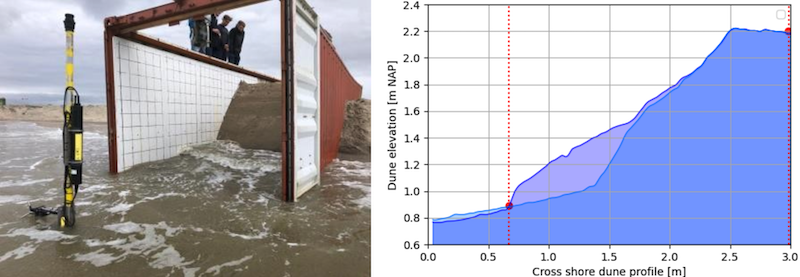Cato de Hullu, Delft University of Technology,
Paul van Wiechen, Delft University of Technology,
Sierd de Vries, Delft University of Technology,
Ad Reniers, Delft University of Technology,
Cas van Bemmelen, Witteveen & Bos,
Introduction
Along a substantial stretch of the Dutch coastline, coastal dunes act as the primary sea defence to protect the low-lying areas behind it from flooding. To ensure that these dunes are strong enough to meet national safety standards, models are used to assess their strength. Even though our modelling capabilities have significantly improved over the years, model uncertainties remain because specific processes are not yet fully understood.
One of these uncertainties is the effect of sediment grain size on dune erosion, causing the relative importance and effect of this parameter to differ significantly among dune erosion models (van Wiechen et al. 2022).
Approach
Field experiments to study the effect of sediment grain size on dune erosion were conducted from September 24 until September 27 2022. Two open shipping containers were placed in the intertidal zone and acted as coastal wave flumes. Inside both containers, artificial dunes consisting of different types of sediment were built and exposed to wave attack during high water. In total six experiments were conducted in which 4 different grain sizes were tested. Dune profile development and erosion volumes were monitored using GoPro images and GPS transects. Hydrodynamic conditions were measured using pressure sensors (RBR) and velocimeters (ADV).
Analysis and results
Wave impact theory (Fisher et al. 1984; Larson et al. 2004) was used to (1) compare the incident hydrodynamic conditions to measured erosion volumes and profile development in time, and (2) isolate the relative importance of sediment grain size on dune erosion. Preliminary results imply that larger grain sizes result in smaller erosion volumes. These findings will be presented at the NCK days.
References
Fisher, J. S., Overton, M. F., & Chisholm, T. (1986). Field measurements of dune erosion. Coastal Engineering, 2 , 1107–1115.
Larson, M., Erikson, L., & Hanson, H. (2004). An analytical model to predict dune erosion due to wave impact. Coastal Engineering, 51, 675–696.
van Wiechen, P.P.J. ., de Vries S., Reniers, A.J.H.M., Aarninkhof, S.G.J. (2023). Dune erosion during storm surges: A review of the observations, physics and modelling of the collision regime. Submitted toitted to Coastal Engineering


Figure 1: a) Extraction dune profile contour from GoPro image. b) Artificial dune inside container, exposed to run c) Definition of the erosion volume.
I. Surname1*, F.N. Another-Surname2 , Y. Next-Surname2
1 University Name, Country; 2 Organization Name, Country
* Corresponding author: mail.name@organization.org


